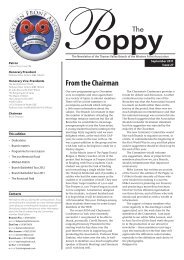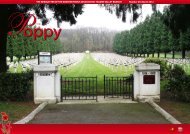The above group photo is of the staff - The Western Front Association
The above group photo is of the staff - The Western Front Association
The above group photo is of the staff - The Western Front Association
You also want an ePaper? Increase the reach of your titles
YUMPU automatically turns print PDFs into web optimized ePapers that Google loves.
area which was to prove fertile ground for<br />
recruiting particularly during <strong>the</strong> early part<br />
<strong>of</strong> <strong>the</strong> 20 th Century. In 1881 <strong>the</strong> East<br />
Devonshire Regiment had <strong>the</strong> honour to<br />
be renamed thus becoming arguably<br />
Lancashire’s most famous regiment, <strong>the</strong><br />
Lancashire Fusiliers.<br />
<strong>The</strong> “Shouting Fusilier”. <strong>The</strong> first<br />
physical evidence <strong>of</strong> <strong>the</strong> relationship<br />
between <strong>the</strong> Fusiliers and Salford came<br />
in 1905 with <strong>the</strong> unveiling <strong>of</strong> <strong>the</strong> statue <strong>of</strong><br />
<strong>the</strong> “Shouting Fusilier” on <strong>the</strong> junction <strong>of</strong><br />
Oldfield Road, (A5056) and Chapel<br />
Street (A6). <strong>The</strong> statue was designed by<br />
George Frampton RA, who was also<br />
responsible for Peter Pan in Hyde Park.<br />
It commemorated <strong>the</strong> many townsmen <strong>of</strong><br />
Salford and particularly <strong>the</strong> Volunteer<br />
Active Service Companies who had<br />
served in South Africa during <strong>the</strong> Boer<br />
War. <strong>The</strong> memorial specifically<br />
commemorated <strong>the</strong> battle <strong>of</strong> Spion Kop<br />
fought on 24 th January 1900 during <strong>the</strong><br />
campaign to relieve Ladysmith. Later<br />
th<strong>is</strong> year it <strong>is</strong> planned to rededicate <strong>the</strong><br />
memorial to symbol<strong>is</strong>e <strong>the</strong> completion <strong>of</strong><br />
<strong>the</strong> Chapel Street regeneration scheme.<br />
South Africa. Spion Kop one <strong>of</strong> <strong>the</strong><br />
hardest fought battles during <strong>the</strong> Boer<br />
War, 1900 to 1902, As part <strong>of</strong> a<br />
Lancashire Brigade, <strong>the</strong> Lancashire<br />
Fusiliers captured <strong>the</strong> feature know as<br />
Spion Kop at night only to find that it lay<br />
open to <strong>the</strong> enemy’s guns by day. <strong>The</strong><br />
exposed plateau was a death trap and<br />
through that long day, 300 Brit<strong>is</strong>h<br />
casualties were inflicted by accurate Boer<br />
rifle fire and field artillery. <strong>The</strong><br />
Lancashire Fusiliers suffered 30 per cent<br />
casualties including two thirds <strong>of</strong> <strong>the</strong>ir<br />
<strong>of</strong>ficers. Unable to dig trenches in <strong>the</strong><br />
rocky ground, almost all <strong>the</strong> dead were<br />
killed by single rifle shots to <strong>the</strong> head;<br />
such was <strong>the</strong> skill <strong>of</strong> Boer marksmanship.<br />
Although <strong>the</strong> cost was high, Spion Kop<br />
and <strong>the</strong> Lancashire Fusiliers’ later<br />
16<br />
successful attack on Pieter’s Hill led to<br />
<strong>the</strong> subsequent relief <strong>of</strong> <strong>the</strong>ir beleaguered<br />
comrades besieged in <strong>the</strong> town <strong>of</strong><br />
Ladysmith. Such gallantry was<br />
recogn<strong>is</strong>ed by <strong>the</strong> award <strong>of</strong> <strong>the</strong> primrose<br />
hackle to be worn on <strong>the</strong> left side <strong>of</strong> <strong>the</strong><br />
headdress as a battle honour, <strong>the</strong><br />
Regimental motto <strong>of</strong> “Omnia Audax”,<br />
“Audacious in everything” and <strong>the</strong> Red<br />
Rose <strong>of</strong> Lancaster to be borne on <strong>the</strong><br />
Regimental Colour.<br />
<strong>The</strong> Great War. Clearly <strong>the</strong> biggest<br />
impact on Salford was <strong>the</strong> First World<br />
War and today <strong>the</strong>re <strong>is</strong> a fine stone<br />
cenotaph twenty feet high surmounted by<br />
a Sphinx situated on <strong>the</strong> Crescent<br />
opposite Salford University. Th<strong>is</strong> <strong>is</strong><br />
dedicated to <strong>the</strong> eleven battalions <strong>of</strong><br />
Lancashire Fusiliers ra<strong>is</strong>ed in Salford in<br />
World War<br />
1. <strong>The</strong>se<br />
include six<br />
Territorial<br />
battalions<br />
from <strong>the</strong> 7 th<br />
and 8 th<br />
Battalions<br />
and five<br />
New Army<br />
battalions<br />
including <strong>the</strong><br />
15 th , 16 th ,<br />
19 th, 20 th and<br />
21 st<br />
Battalions<br />
locally<br />
known as <strong>the</strong> “Salford Pals”. It was <strong>the</strong><br />
Salford Pals that fought bravely as part <strong>of</strong><br />
<strong>the</strong> 32 nd (Salford) Div<strong>is</strong>ion in <strong>the</strong> Battle <strong>of</strong><br />
<strong>the</strong> Somme in 1916 suffering heavy<br />
casualties. <strong>The</strong>re <strong>is</strong> a memorial to <strong>the</strong><br />
Salford Pals erected in <strong>the</strong> village <strong>of</strong><br />
Authille in France on <strong>the</strong> battlefield where<br />
many <strong>of</strong> <strong>the</strong>m fell.<br />
TO VIEW DESPATCH WITH LARGER<br />
TYPE AND SEE ALL PHOTOS IN COLOUR<br />
VISIT OUR WEBSITE



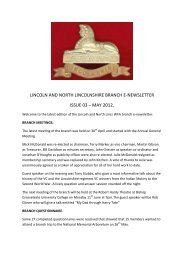
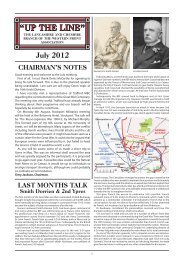
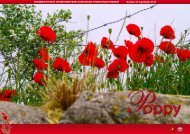
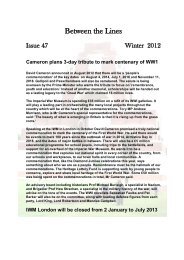
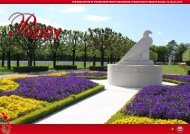
![Fromelles Australian Working List[1].pdf - The Western Front ...](https://img.yumpu.com/29972632/1/184x260/fromelles-australian-working-list1pdf-the-western-front-.jpg?quality=85)
